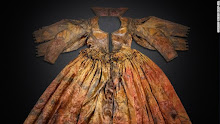My article, "Titanic Glamour," is featured in the winter issue of SEASON magazine (scroll to page 48.) I've reprinted it below, adding images shared by fashion historian Randy Bryan Bigham, author of Lucile - Her Life By Design.
.................................
TITANIC GLAMOUR
 |
| Bridal sketch by Lucile Courtesy: Randy Bryan Bigham |
Whenever you
read about the RMS Titanic—the fabled
“floating palace” that sank on its maiden voyage in April of 1912—gilded glamour
and high fashion are always part of the intrigue. During its “dressing hour,”
when first-class passengers dressed for dinner following white-tie protocol,
many ‘Lucile’ gowns—gingerly unpacked by ladies’ maids from grand steamer
trunks—were worn by patrons unaware the celebrated designer, sailing incognito,
was aboard. British couturiere Lucile, Lady Duff Gordon, traveling to expand
her business in America, was on the Titanic
with her husband, Sir Cosmo Duff Gordon, and her assistant, “Franks.” (All three were saved
when disaster struck, but there was a whiff of scandal surrounding the
circumstances!)
 |
| Lily Elsie in Lucile, Ltd. wedding gown, circa 1911 Courtesy: Randy Bryan Bigham |
Lucile was internationally
famous for her femme-femme evening clothes and bridalwear made of gossamer layers
of silk with delicate beadwork (some say she was the first to design a
“corsetless” gown); she was also known for her elegant ‘naughty but nice’
lingerie—a bridal trousseau darling of the rich and royal. Indeed, the
innovative designer was favored by fashionable brides around the world: stars
of stage and screen, fiancées of business tycoons, daughters of
the nobility (too many to name here!) One of Lucile’s beautiful young brides
was a fellow Titanic passenger—recently
married to the older and very wealthy John Jacob Astor IV; Madeleine and her
unborn child made it to safety, he did not.
Lucile’s élan even spilled over into the popular Downton Abbey television series 100 years later! There’s a scene in
season three—soon before Lady Edith Crawley’s ill-fated wedding—when Cora, Lady
Grantham (quite the fashionista), informs Violet, the Dowager Countess, that
the bride would, of course, be wearing
‘Lucile.’
 |
| Mary Marvin in Farquharson & Wheelock design Courtesy: Randy Bryan Bigham |
Mary
Farquharson Marvin—the daughter of another high-society couturiere—and her
husband were also first-class passengers on the Titanic, returning to New York from their European honeymoon. Mary’s
mother was half of the Farquharson & Wheelock design team—two Scottish
sisters with fashion ateliers in Washington, DC and New York City. Naturally,
they designed Mary’s stylish wedding gown and, because of their fame, she
appeared in Vogue wearing the bridal
confection. (A decade later, Farquharson & Wheelock created the lace and
silk tabard-style gown for Biltmore heiress Cornelia Vanderbilt’s wedding in
Asheville, NC.)
The family
of Mary’s husband, Daniel Warner Marvin, were pioneers in the motion picture
production business and, although their wedding in early 1912 was not filmed, the
ceremony was restaged for the camera a few months later, making international
news. The London Daily Mirror
reported it as the very first wedding to be “cinematographed.” Sadly, like many
men on the sinking Titanic, Mary’s
husband saw his young wife safely aboard a lifeboat, then stayed behind and
went down with the magnificent ship. ~
































































